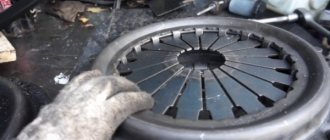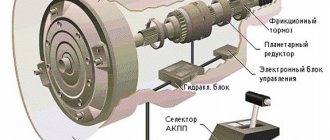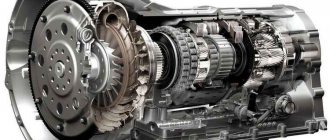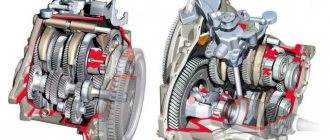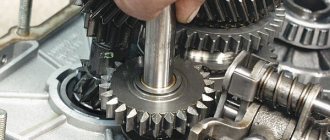- Automatic transmission vibration
- Knock in automatic transmission
- Signs of a torque converter malfunction
Almost any automatic transmission is very sensitive to incorrect, aggressive driving style, to bad Russian roads, to the quality of the filled oil, to exceeding the permissible weight of the towed vehicle, and much more.
Sometimes the quality of the unit itself is not very good. If it fails for these reasons, then the emergency light will signal this, the emergency mode will turn on, and then the only way is to service, and urgently.
But there are cases when everything seems to be working, the car is driving, the gears are switching, but something is wrong. In what situations is the assistance of repair specialists also urgently required? Vibrations or knocks in the machine should alert the owner. They may indicate or lead to serious problems. What are they talking about?
Automatic transmission vibration
Not very common, but even more unpleasant, automatic transmission vibration can be caused by wear of the support. Other possible reasons:
- On all-wheel drive vehicles there are malfunctions in the transfer case.
- The torque converter locking package has burnt out.
- Wear or breakdown of the mechanical parts of the machine.
- Malfunctions in other units that transmit vibration to the box.
The transfer case, torque converter, or faulty components will need to be repaired or replaced.
Failure to promptly address vibration will lead to failure of the automatic transmission in the future and will greatly increase the cost of repairs. Our service specialists will professionally diagnose the problem and identify the true causes of vibration.
Typically the repair time in this case is 1–2 days. The approximate cost of repairing the transfer case is from 6,000 rubles, blocking from 1,800 rubles, restoring the support from 800 rubles.
Gearbox and transfer case malfunctions
Malfunctions of the gearbox and transfer case include wear of the gear teeth, chipping of their working surface, breakage of the teeth, wear of bearings and their seats, splined shafts, cam clutches, which manifests itself in the noisy operation of the gearbox, self-switching of the gears, difficulty in engaging them or simultaneously engaging two gears
Malfunctions in the gear shift mechanism : deflection and jamming of the rollers, wear of the clamps, breakage of the clamp springs, which leads to the gears turning off themselves.
Malfunctions include wear of oil seals and oil deflectors, loosening of bolts and nuts securing bearing caps and plugs , which disrupts the tightness of connections and causes oil leakage from the crankcase.
During maintenance of the gearbox and transfer case, an external inspection is carried out, places where oil is leaking through the seals, from under the covers and plugs are identified, the nuts and bolts securing the covers and the box housing are tightened, the operation of the box is listened to with a stethoscope or other means, and the heating is checked. A technically sound gearbox and transfer case should operate without noise and heat with easy, silent gear shifting.
For passenger cars with remote control gearboxes, the length of the intermediate rods is adjusted (by rotating their tips) to ensure a consistent position of the shift lever (on the steering column) and the gearbox gears. When moving the lever from the engaged position to the neutral position, the gears should completely disengage.
Caring for the lubrication of boxes consists of periodically replenishing and changing the oil, as well as cleaning the drain plug magnet and flushing the breather air channel (to avoid oil leakage through the seals).
To lubricate gearboxes and transfer cases, use automotive transmission oil (nigrol) GOST 542-50 summer or winter (depending on the season), automotive transmission oil GOST 3781-53 and automotive transmission oil TAp-15 and TAp-10 GOST 8412-57 with anti-wear additive.
The lubricant in the gearbox and transfer case is changed every 6,000-12,000 km with preliminary flushing of the crankcases and gears with kerosene (preferably diesel fuel).
After draining the used oil (preferably in a heated state), 1.5-2.0 liters of kerosene are poured into the crankcase, one or both rear wheels are suspended, the engine is started, first gear is engaged and the engine is allowed to run for 1.5-2 minutes.
After this, kerosene is drained through the drain hole, clean flushing oil (spindle AU) is poured in and the engine is started again for 1-2 minutes. Then this oil is drained and fresh oil of the appropriate grade is added.
Knock in automatic transmission
Knocks or extraneous noises in the automatic transmission appear due to disturbances in its operation caused by mechanics or hydraulics. Continued use will also cause the box to malfunction. Most likely reasons:
- Insufficient oil level in transmission
- Damage to the machine pump.
- Malfunctions in the operation of the solenoid valves in the box.
- The planetary gear housing or gears are worn or damaged.
It may be necessary to: top up or change the oil, repair the pump, gearbox mechanics or planetary gear elements.
In this case, troubleshooting will also take up to two days and cost from 600 rubles.
Common signs of automatic transmission failure
Oil condition
An automatic transmission uses transmission oil (or ATF) to cool and lubricate many parts of the automatic transmission. However, oil quality can deteriorate over time, so it is critical to check the condition of your vehicle's transmission fluid at least once a month. By checking the oil in your automatic transmission monthly, you can learn a lot about its condition and whether it needs to be replaced.
Remember that dirty or burnt fluid is a case when your automatic transmission requires an urgent oil change. New transmission fluid is a clear, pinkish-red color, while worn transmission fluid is dark brown or black (often with metal or dirt particles). Also check the smell of the oil, as a burning smell is a clear sign of problems.
The oil in the automatic transmission must be changed at least once every 2 years or 40-60 thousand kilometers, but if the car is operated in difficult conditions, then the fluid must be changed every 20 thousand km.
Low oil level
An automatic transmission requires a certain amount of ATP to operate smoothly; too little fluid can lead to catastrophic consequences. Problems that can be caused by low fluid levels include slipping, shaking, overheating and overall system failure.
Checking the transmission fluid level is a simple process using the dipstick. If the level is low, then your job is to simply add a little more than the recommended amount of ATP to your box. However, low fluid levels can also indicate an oil leak within your transmission, which is one of the signs of automatic transmission failure on our list.
Signs of leaks
Leaks generally originate from a gap somewhere in your transmission. The most common places where fluid leaks occur are power lines, crankcase, or defective gaskets. Replacing the defective part will sometimes be enough to fix the leak, although the difficulty of replacing the gaskets will vary.
Fluid leaks in the automatic transmission require special attention; the longer you wait, the more oil will leak. This will ultimately lead to problems associated with low fluid levels.
Automatic transmission overheating
An overheating automatic transmission is one of the worst things that can happen to it. Is it worth paying attention to this? Overheating the automatic transmission can cause it to malfunction, as well as shorten its service life.
It's not surprising that drivers are always reminded to change the ATF, because transmission fluid is vital for your automatic transmission. It is not at all easy to identify an overheated box, but the best way to do this is to check the fluid.
The most common cause of overheating is poor oil quality, so look for any signs of poor quality, dirty or burnt fluid. Each of these signs indicates a different automatic transmission problem and indicates an immediate fluid change.
Transmission slip
If you step on the gas pedal and find that you are not accelerating but the engine speed is rising, this is a sign of transmission slip.
There are many reasons why an automatic transmission may slip, for example:
- Low fluid efficiency;
- Faulty solenoids;
- Burnt clutch discs;
- Worn gears and so on.
If you are experiencing a slip on the road, the best thing to do is to avoid moving the vehicle as much as possible, as sliding can cause rapid wear on the clutch. If the clutch discs wear too badly, you will have to remove the transmission to replace them, which can be very expensive.
Signs of a torque converter malfunction
The torque converter is one of the main components of an automatic transmission, similar to the clutch and controls the operation of the entire mechanism. Irregularities in its operation or final breakdown will necessarily affect the operation of the transmission. One of the consequences of a malfunctioning torque converter is automatic transmission vibration.
Other signs indicating its malfunction or breakdown:
- Lack of movement of the car in any direction, while a shock is felt when shifting gears.
- Slipping when starting off.
- There is no main pressure.
In these cases, replacement of the torque converter is most often required. The lack of pressure can be corrected by replacing the oil pump reactor shaft.
Repairs here will require no more than two days, replacing the torque converter will cost from 2,500 rubles, restoring the reactor from 300 rubles.
Features of the mechanism
Before discussing the signs of a faulty transmission, you should understand how this unit functions in general. The purpose of the gearbox is to change torque and transmit it from the power unit to the wheels. With the help of a gearbox, these elements can be separated for an unlimited period of time.
In the case of a mechanical transmission, the torque changes gradually (the role of the stage is played by two interacting gears). Moreover, each stage has its own gear ratio. When the driver changes the position of the lever, the gears move along the shafts and then engage with each other. This is what makes it possible to change the operating modes of the vehicle. Malfunctions of the manual transmission lead to the fact that the car becomes unsuitable for use, or its use will be difficult.
Possible reasons
There are several main reasons that lead to poor bike gear shifting:
- Shirt with cables - must always be in good condition. To check the wear of the cables, adjust the shifter and examine their internal condition. Defects in cables occur in the form of individual untwisted wires and hooks. A common reason is their stretching or wear, damage to the protective cap (from promiscuity). The shirt may also be cut;
- Wear of the cassette or chain - due to improper use of the bike or exceeding the allotted resource;
- Lack of necessary lubrication - the elements do not work well, gears are difficult to shift;
- Distortion, wear of the rear derailleur or a bicycle hanger - the mechanism may jam due to problems with the bracket. This often happens after collisions or falls - the rooster can bend or become deformed;
- There is some play in the rear derailleur - this problem occurs periodically when using a bicycle. It causes delays when changing gears on bicycles;
- Accumulated dirt and excessive use of lubricant, incorrect adjustment of parts also contribute to problems with speed control;
- Breakdown of the switch and its spring or failure of its settings;
- Failure of the shifter itself - cheap plastic wears out;
Therefore, if problems arise in shifting gears, you should check all possible causes, although the most common are contamination or lack of adjustment. Bicycle parts wear out only under significant, prolonged loads.
History of automatic transmission
The first automatic transmissions appeared in the middle of the last century. These were quite primitive designs that had two or three stages. Naturally, a car with such a transmission did not have good dynamic characteristics, so the automatic transmission was not initially very popular on the market. Only in America could one often find cars that received automatic transmissions, and thanks to the huge displacement of engines and the low price of fuel, automatic transmissions were popular in the market.
For most car owners, automatic transmissions were not suitable precisely because of a significant increase in fuel consumption, a decrease in the dynamic characteristics of the engine, and the reliability of such units left much to be desired. However, subsequently the technology was constantly improved, the so-called valve body appeared, which made it possible to change gears as smoothly and correctly as possible, while the car made excellent use of the dynamic power characteristics of the engine, which increased the efficiency of using such a transmission.
Modern automatic transmissions are fully automatic, can have 6-7 or even 8 steps, provide excellent dynamics, therefore, in terms of fuel efficiency, such transmissions are not inferior to manual transmissions. It is not surprising that, given all the excellent performance characteristics, such transmissions have become extremely popular and in recent years have almost completely replaced manual transmissions.
The importance of proper repairs
Often car owners do not think about where and how to repair an automatic transmission. We choose the first service we come across, where they offer us to fix certain breakdowns at a low price. However, you need to remember that such units have a complex design, so it is possible to correctly determine the malfunction and restore the unit only if special diagnostic equipment is used, and the technicians performing such repairs have extensive practical experience.
If you skimp on the quality of service and repairs, then soon even the simplest breakdown, which could be fixed relatively simply and inexpensively, will lead to the need for major repairs and restoration of equipment. To avoid this, you should contact only those companies and workshops that specialize in working with automatic transmissions, offering appropriate quality guarantees. Therefore, it would be a good idea to first study the reviews of other car owners, and only after that give the car and automatic transmission for service and repair.
